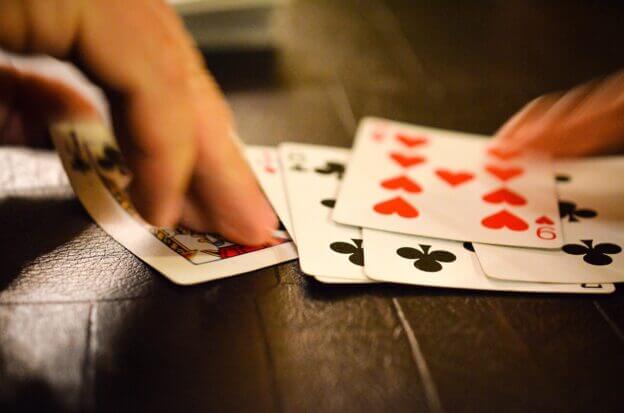Your PLO strategy and your ability to execute it on a consistent basis, are the key to your in-game success. The best poker players have the best strategies, period.
Once you’ve learned all the game’s rules, the next step is crafting an effective long-term Omaha poker strategy, which should be focused on the following principles:
If you currently play Texas Hold ‘Em, make sure to also check out our post for players switching from NLHE to PLO.
1. Game Theory Optimal Poker
For a long time, poker was considered to be a game of reads and exploitation. In today’s poker environment, poker software plays a huge role in the creation of game theory optimal (GTO) strategies that are based on playing a balanced, less exploitable game.
Working with GTO solvers is not about memorizing thousands of models, it’s about understanding the principles behind patterns that emerge. The solver doesn’t tell us why a hand is a raise. Our job is to make sense of the output by applying logic.
In this clip from our 10-Week PLO Transformation course, we talk about the fields of strategy that need to be discovered to dominate the game.
Omaha poker strategy is very situational. To work on your game, you need to identify different spots and how you are deviating from GTO. A great starting point can be our blog posts that focus on specific scenarios:
If you are interested in exploring variations to the typical 4-card PLO cash games, we also cover that in our blog, so make sure to check out our posts on:
There are multiple theoretical concepts that you should know by heart because they are relevant to any given area of the strategy grid. In the following section, we break them down for you.
Equity
Equity is the share of the pot that is yours based on the possibility that you will win the pot at that point in play. It amounts to the chances you have of winning the hand at that given moment.
Often you will see a connection between how much equity you have and the size of your bets. The correlation is in essence that the more equity you have, the more often you bet.
On the other hand, when you are holding lower equity, you’re usually going to check more often.
If you want to practice or learn more about PLO equities, check out our PLO Equity Calculator.
Calibration
Calibration means studying the context of the situation, understanding the strength of your starting hand in regards to that situation, and then making the right play. That is where contextual value comes in, more on that in this clip from our PLO Basics series.
Different hands have different combination qualities. One situation might be preferable with one hand, but not with the other.
In this clip from our PLO Launchpad course, we talk about how a hand’s character and strength can be relative to the context.
Think about how your hand will play out and whether it is appropriate for the situation you’ll be in.
Efficiency
Efficiency in PLO refers to using all relevant components in your starting hand or range and force your opponent into the most optimal part of the game tree, for you.
Efficiency drives decisions.
Understand in which part of the game tree your specific hand or range does best and push the action there. If you don’t see a clear advantage, it usually means that both equities are very close.
You will then realize whether or not you want to have a betting range at all. Instead of trying to figure out which hands to bet 12% of the time, you can just choose consistency over perfection, and simplify your frequency by checking your full range.
In this clip from our courses, we go through some examples of hand efficiency in Pot Limit Omaha.
2. Exploitation
When you get a read on your opponent, find a weakness, and know how you adjust to it, you should deviate from your baseline strategy and take advantage of their mistakes.
However, be careful. The information you have on your opponent shouldn’t have the ultimate power over your strategy. If your read is wrong, you’ll lose a lot by choosing the wrong strategy.
Be patient and wait for the right moment, otherwise, you are going to have a massive leak that will hold you back in your PLO career at a very early stage.
Deviating from GTO
Our goal for exploitation is to build reads. But those reads are oftentimes a lot more accurate if they’re coming from a GTO perspective.
That is going to be our absolute target. Understanding GTO on a fundamental level, spotting deviations, and knowing how to exploit those deviations.
To exploit opponents, we recommend following this step-by-step process:
- Understand the GTO baseline
- Identify how your opponent deviates from GTO
- Exploit your opponent’s weaknesses
- Limit the downside and minimize counter exploits
In this clip from our 10-Week PLO Transformation course, we outline an example of these steps being put into action.
Minimum Exploitation
One of the biggest problems you can have is overestimating the reads you have on your opponents. You could see a small statistic and already be thinking that you can exploit your opponent by just maximally going against it.
If you’re making extreme adjustments to your opponents, you also expose yourself to becoming exploited and losing the money you were making from your adjustments back to them.
You should never focus too much on making drastic adjustments to individual opponents, as they can become big mistakes. Your read can be off, or they can counter adjust before you know it.
Although the idea might be attractive in your mind, it is not the best approach.
Making minimal adjustments allows you to maximize your win rate and at the same time prevents you from making massive mistakes on an incorrect read.
Bluffing
Bluffing is part of a good, aggressive strategy. Betting the right frequency gives opponents a very hard time, and they will have no real options to exploit you. The same is true for calling the right frequency of villain’s bluffs, dubbed Minimum Defense Frequency.
What makes a bluff effective?
-
- No showdown value – A lot of times there is a direct connection between a hand that can’t win at showdown that ends up turning into a bluff.
- Blocking opponents’ continuing range – Our opponent will have natural calls or continuing hands in their range that we can block.
- Unblocking opponents’ folding range – You don’t want to have a missed draw in your hand but rather in your opponents’ range, as they are naturally folding when we bet.
When bluffing, always consider:
-
- Context – The factors are always different, as well as your bluffing hands.
- Equity – Always consider what is happening on streets to come.
- Blockers / Unblockers – Your blocker/unblocker has to be relevant.
- Showdown value – How much showdown value do you have?
- Facing aggression – Can you face a bet or raise, or are you likely dominated?
In this clip from our Quick Wins course, we go over several hand scenarios and the thought processes to decide whether bluffing is the right play.
Just remember, if your opponent is calling too much then you should bluff less and exploit your opponent’s tendendcy by value betting a wider range of strong hands.
3. Optimization
An effective strategy should be evaluated and worked on continuously.
If you’re incorporating a certain line into your game, you have to continuously evaluate it and see if it’s actually working in the context of how people are reacting to it. And then improve it and optimize it based on the new information consistently.
In this clip from our 10-Week PLO Transformation course, we talk about the research methodology process we use for coming up with strategies.
Before you head to the table, put in the work. You have to become obsessed with that type of work. Execution happens at the poker table after the research, learning, and training is completed.
Winners analyze every game to avoid making mistakes over and over again.
Analyzing Your Game
When it comes to working on your game it’s all about what to work on, how to work on it, and when to work on it, focus on situations that:
- Have a high impact on your win rate.
- Occur with a high frequency in-game.
- Are easy or relatively fast to solve.
Repetition is king when it comes to recognizing patterns.
Make sure to keep track of the most important principles because it will help you to integrate it into your system and become a better poker player much quicker.
Use this step-by-step approach to review your hand and start recognizing the patterns in your game.
Learning
Approach poker as a game of never-ending learning and discovery.
You have to look at the same thing from multiple angles, over and over again. That’s learning, that’s discovery, and that’s passion. Not the passion for playing the game, but for learning the game, for discovering strategies.
In this clip, we talk about the learning process with our poker video courses.
The improvement cycle functions as a framework for you to continuously improve and evaluate your game. Always understand what cycle you want to go through to improve your game consistently.
If you already know PLO basic strategy, our recommended PLO courses for beginners are a great place to improve your strategy, from our +800 PLO poker training videos:
- The Launchpad talks about fundamentals and basic PLO preflop and postflop strategy.
- Escape the Micros is great if you want to learn about how to deal with specific tendencies at low and micro stakes PLO, like facing preflop limpers. Crushing Small Stakes PLO is a great course to gain even more insights on these exploitative plays.
- The 10-Week PLO Transformation builds up from beginning parts of the game and slowly expands to a more advanced strategy.
Become an active learner and improve your game as fast as possible with our 350+ PLO quizzes, which train you on many preflop and postflop decisions based on lesson content and with further explanations.
Join the PLO Mastermind forums to exchange PLO strategies with people that are in the same path as you are.
Emulation
When it comes to poker, you don’t always have to reinvent the wheel.
An effective strategy is used by top players consistently. Look at what some of the top players are doing and how that could work out in your current environment.
Incorporate it so well into your game that you end up improving it.
Conclusion to PLO Strategies
Following reads and gut feelings sounds less complicated than studying mathematical equations and understanding the mechanics of a balanced PLO strategy. But if you base your strategy solely on your personal experience, it will be biased. Instead, base your reasoning on game theory optimal poker and empirical data.
Your goal is to use GTO as a framework to then find the best strategy by utilizing information and assumptions about your opponents. Your strategy might change based on your opponents’ behavior, but you shouldn’t expose yourself to the downsides, like playing an unbalanced strategy and risking being exploited yourself.
Optimization is a massively important concept when it comes to crafting and utilizing strategy. You can’t do it all by yourself, and you don’t have to.
Stop grinding, and start crushing.



























